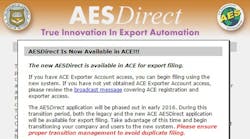If you're among those who've been using the U.S. Census Bureau's AESDirect portal to file electronic export information — the system handled about 900,000 entries each month — things are changing as the portal is now folded into ACE. But there also may be an opportunity to improve your business processes, argues one fleet management technology firm executive.
ACE, or the Automated Commercial Environment, is familiar to most trucking companies and fleets with cross-border business into Canada and Mexico. It's the "single window" initiative and accompanying import-export system launched to help facilitate intergovernmental and interagency data flow for goods going in and out of the country.
And now AESDirect, an online portal dating back to the Clinton Administration that's been used to file electronic export information (EEI) for most commodities the United States exports valued over $2,500, is being transitioned to ACE. The old AESDirect portal was designed as a tool for the Automated Export System and now essentially will be rebooted as another software app in the ACE suite of services, says Rob Pedersen, director of customs compliance and government solutions at transportation logistics and management firm Descartes.
Here are three things to know about AESDirect's inclusion in the ACE system:
1. ACE is "basically designed to be one repository of information for many different government agencies to access," Pedersen notes, and is considered the system of record for government compliance. AESDirect data already has been included in the ACE system since mid-2015. "What's going away is the customer-facing front end of AESDirect — it'll be wrapped into the ACE portal."
2. The discontinuation of the AESDirect online portal and its shift now to an ACE tool was delayed a bit this year. It was originally to begin Feb. 15 with groups of AESDirect users migrated to ACE each week, but was pushed back to begin Feb. 29 with groups migrated every two weeks, wrapping up in late April.
3. Those who filed EEIs with the AESDirect portal — the "principal party in interest in the U.S., or basically the folks making the money" from an export, Pedersen notes — may have integrated back-office systems with AESDirect, since it could be used for a number of functions. And if they did, they'll need to migrate off of that integration by the end of this month.
Opportunity?
Exporters have either used the AESDirect tool to file EEIs themselves or hired a customs brokerage or third party to file the info, and the transition to ACE presents an opportunity for businesses to rethink how they handle the process, according to Pedersen.
"There's an opportunity to make better use of the data they are currently submitting to the U.S. government — they can reuse that data to better serve their larger business plans," Pedersen says. He notes that he's seen many family businesses and legacy systems being used in trucking and private fleets, which makes the industry unique but also could mean companies that chose to go it alone with AESDirect may be doing manual data entry and have the potential to streamline their processes significantly.
That's where a third-party service such as Descartes offers to now file using the ACE tool could help. "We can map information from one resource to another — we have a sophisticated mapping system that can transform a message from one state to another," Pedersen says. "A shipper in one case is actually a consignee in another, for example; we can take the information you'd enter and kind of transform it into a document that meets a different set of regulatory requirements."
"If you're sitting down and crunching the numbers and saying, 'I have my operations folks in my office doing data entry' — which is what you got with AESDirect or now the ACE portal, re-keying in information you've already sent to another party, maybe on a paper document or an electronic one — you start thinking, 'Is my employees' time better spent focusing on my core business?'" he continues. "Maybe they could be building relationships with local manufacturers, local exporters, local importers rather than all this grunt work."



